Last updated: November 27, 2023
Article
50 Nifty Finds #34: Poster Boy for Parks
Photographer Ansel Adams is renowned for his black-and-white images of western American landscapes. His name conjures iconic images of national parks, particularly his beloved Yosemite. Although his 1941 mural project for the US Department of the Interior (DOI) is better known, Adams also worked with the National Park Service (NPS) to create a series of six posters. These affordable versions of Adams’ art provided priceless publicity for national parks.
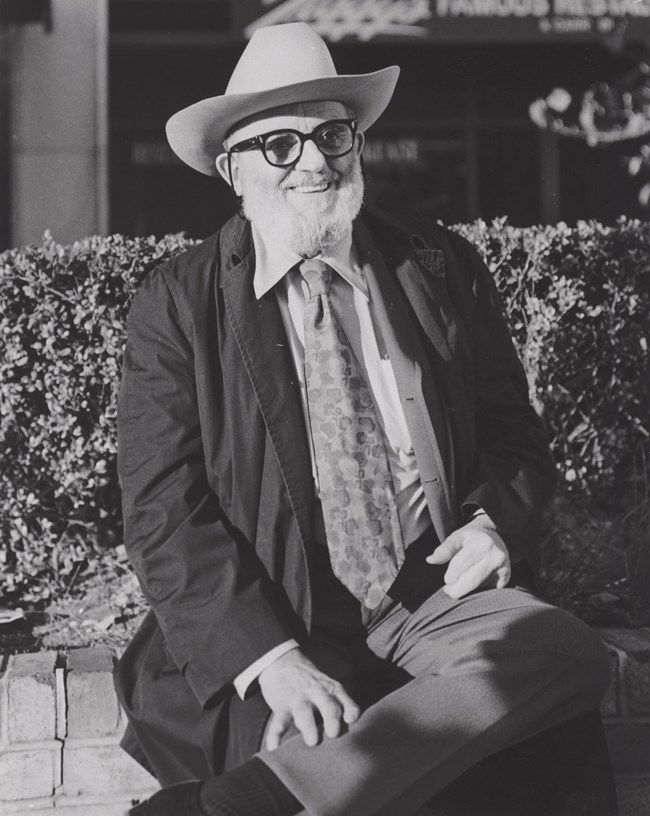
Growing Up in California
Ansel Easton Adams was born February 20, 1902, in San Francisco, California, to businessman Charles Hitchcock Adams and Olive Bray. His early years in San Francisco were marked by several historic events. Adams survived the 1906 San Francisco earthquake but sustained a broken nose that defined his look for the rest of his life. The following year, his family’s fortune, made in the timber industry, was lost in a national banking panic. An only child, Adams was raised by his older parents and live-in aunt. He attended public school until the eighth grade when, following difficulties in school, his father decided he should be tutored at home. His father created a classical education plan that included piano lessons and studying Greek. At age 14 he read James Mason Hutchings' book In the Heart of the Sierras, which caught his imagination. Inspired, he convinced his parents to vacation in Yosemite National Park. Equipped with a Kodak Brownie camera, he took the first images of what would become a lifetime passion.
In 1919, at age 17, Adams survived the Spanish flu pandemic and joined the Sierra Club. He spent six summers accompanying High Sierra tour groups as trip photographer. He was deeply influenced by the organization's environmental credo, and his first published photographs appeared in the Club's 1922 Bulletin. In 1927 Adams received critical acclaim for his Monolith, the Face of Half Dome photograph. For the rest of his career, Adams would be associated with this masterpiece and the techniques he used to produce it.
Setting up Shop
Adams married Virginia Best in 1928 after a long courtship. She was the daughter of landscape painter Harry Cassie Best. Adams displayed his photography at Best’s Studio in Yosemite Valley. The couple had two children, Michael and Anne, who grew up in in the valley. Around 1935 Mrs. Adams inherited her father’s business. They eventually renamed it The Ansel Adams Gallery and passed it onto their children.
Adams worked throughout his life as a commercial photographer, taking assignments from the companies such as Kodak, Zeiss, IBM, AT&T, and Life and Fortune magazines. In 1941 the DOI hired Adams to photograph national parks and monuments, Indian reservations, and Bureau of Reclamation dam projects. The images were to be installed as photomurals in the newly completed Interior building in Washington, DC. World War II redirected funding, however, and the large murals were never created from Adams’ images. After about 1950 Adams didn’t photograph in the field often. Instead, he reinterpreted his earlier images and concentrated on publishing.
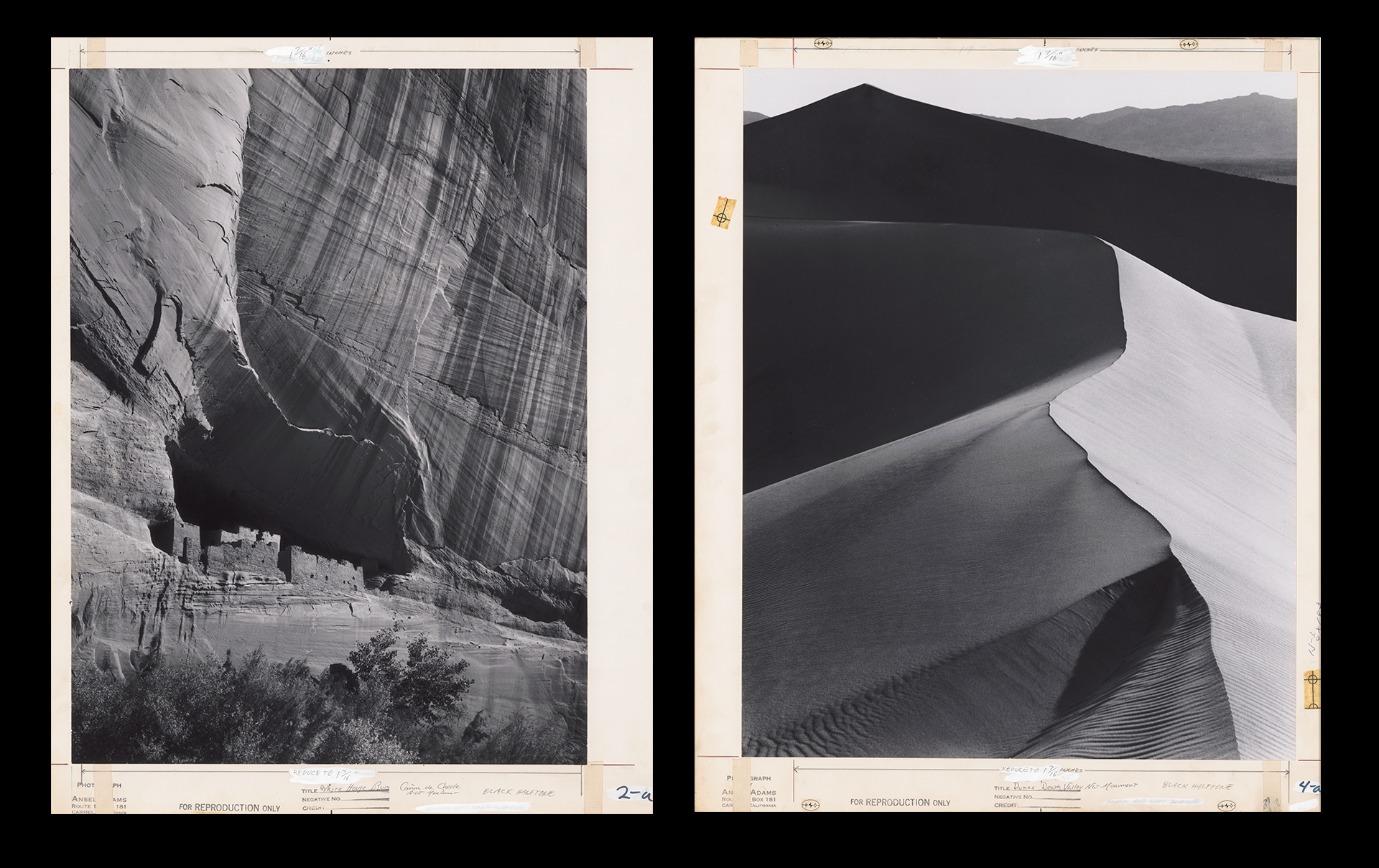
Parkscape Posters
In 1966 the NPS contracted with Adams to provide images for a new poster series. He submitted 13 proofs printed from negatives he had taken previously. The images were of Yosemite, Glacier Bay, Zion, and Crater Lake national parks; Canyon de Chelly and Devils Postpile national monuments; Sur Point on the California Coast; and the Pacific Ocean.
The NPS selected six of the images to turn into posters. The officials who chose the images are unknown. The selected images are:
- Dunes, Death Valley National Monument
- White House Ruin, Canyon de Chelly National Monument
- Detail, Devils Postpile National Monument
- Iceberg, Glacier Bay National Monument, Alaska
- Face of Half Dome [Yosemite]
- Mariposa Grove and Giant Sequoias, Yosemite
When published, Adams’ photograph titles were sometimes changed on the posters.
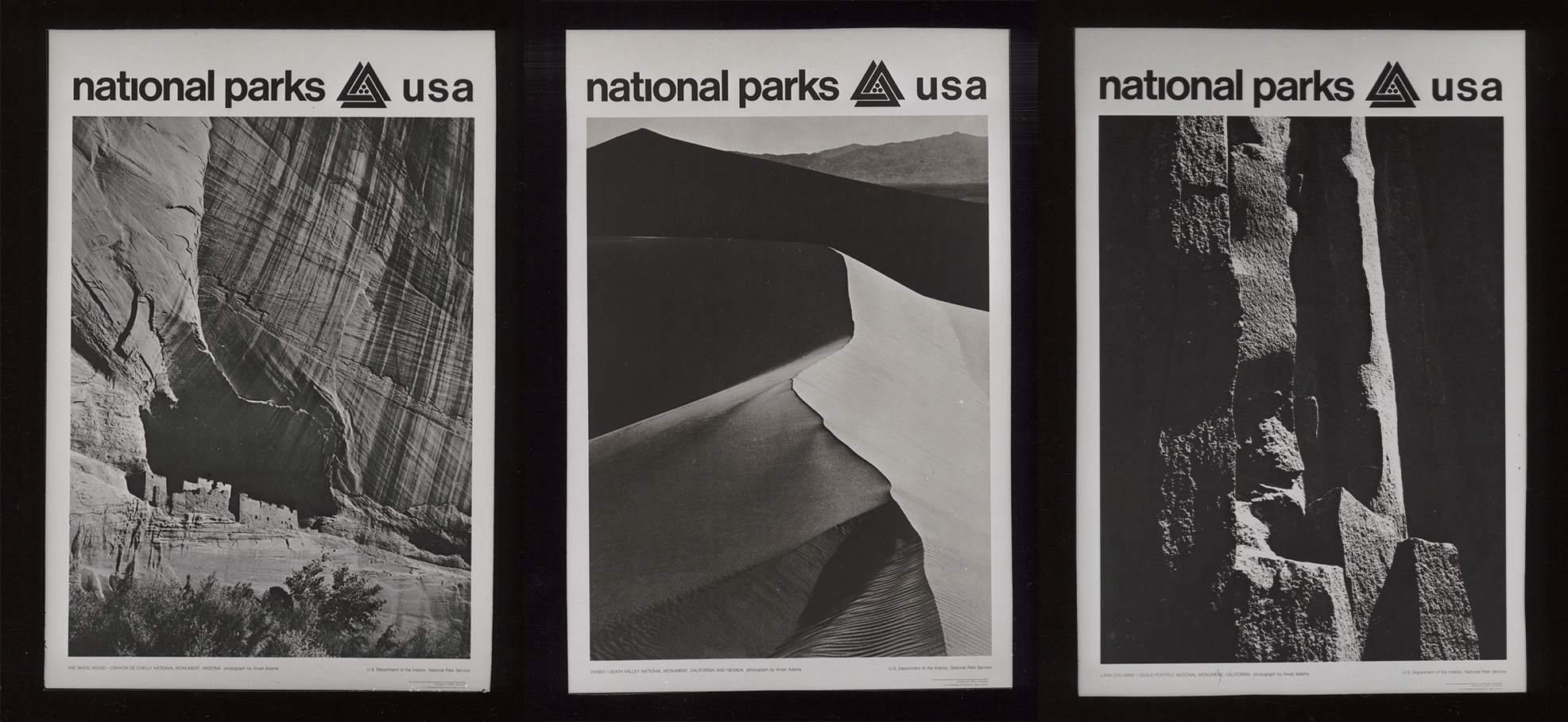
Printed in 1968, the posters were titled "national parks usa" and featured the Parkscape USA symbol launched by Director George B. Hartzog, Jr. in January 1967. Posters featuring Adams’ photographs were “designed to interest the public in the areas in the National Park System.” Each poster measures 28 x 42 inches and is printed in black and white on “sturdy poster paper.” The posters were sold through the US Government Printing Office (GPO) beginning in 1969. They cost 40 cents each or $2 for the set of six. Only 2,000 copies of each poster were printed; 1,750 were sold through GPO, and the remainder were distributed by the NPS. Despite the small initial printing for works by such an iconic photographer, the government never issued a second printing. Because the posters are in the public domain, others have reproduced them over time.
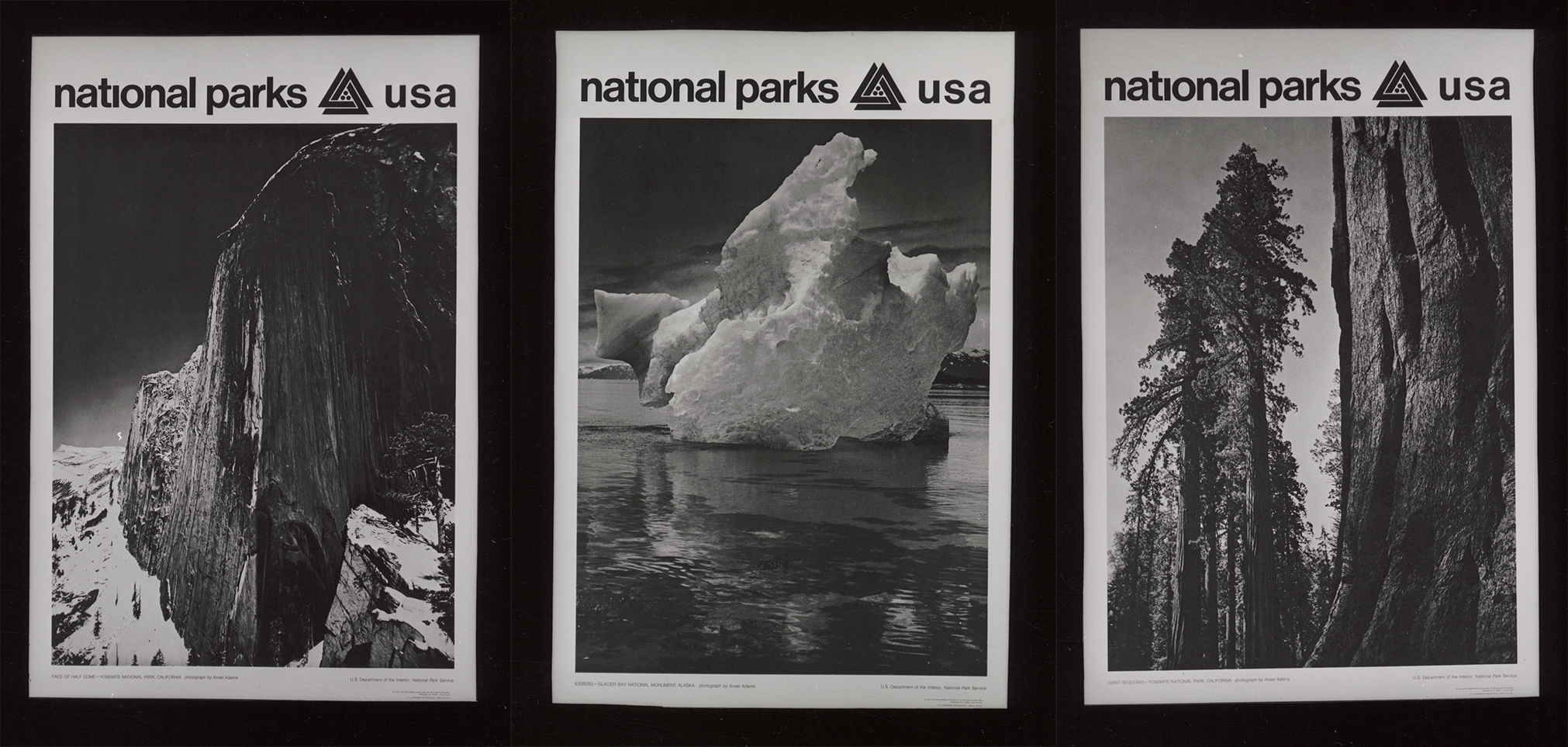
The NPS History Collection includes 12 of the 13 original prints submitted by Adams for the poster series (Face of Half Dome was never received) and the seven prints that weren’t selected. The collection also includes the six 1968 posters and a set of 8 x 10-inch black-and-white proofs of the posters. A seventh poster, featuring Adams’ photograph of the White Throne at Zion National Park, is also in the collection. That poster, printed in 1971 by the Zion Natural History Association, features the national parks USA heading with the Parkscape symbol (despite that it was already discontinued). It’s likely that it was printed from the proof in the NPS History Collection.
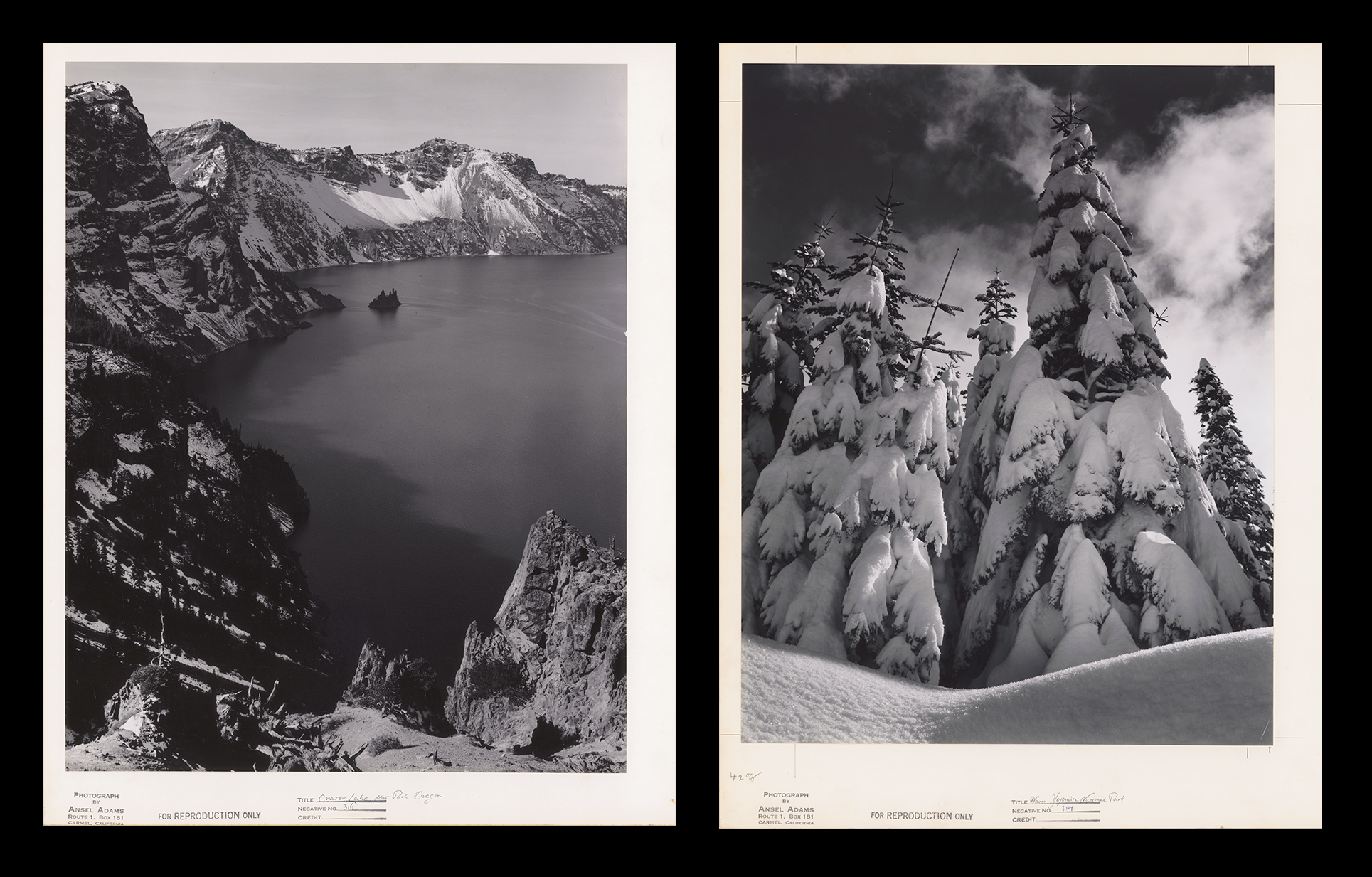
Lasting Legacy
At the time of the 1968 poster series, Adams was the director of the Sierra Club. He served in this role from 1934 to 1971. His career was not only focused on the art of photography but also with the goal of raising awareness for the campaign to preserve the natural landscape and the life it supported. One his most notable works, This Is the American Earth (1960, with Nancy Newhall) was published by the Sierra Club. It is considered one of the essential books in the reawakening of the conservation movement of the 1960s and 1970s. In 1968 Adams was awarded the Conservation Service Award, DOI’s highest honor for non-employees.
Adams wrote and contributed photographs to hundreds of articles and reviews from 1922 until 1984. He published eight portfolios of original photographic prints. Nearly four dozen books bear Adams’s name as author or artist. Adams received numerous awards and honors in his lifetime for artistic works and contributions to conservation. In 1980 Adams was awarded the Presidential Medal of Freedom by President Jimmy Carter who noted, “It is through [Adams’] foresight and fortitude that so much of America has been saved for future Americans.”
Adams died April 22, 1984, in Monterey, California. Shortly after his death, the Minarets Wilderness south of Yosemite National Park was renamed the Ansel Adams Wilderness. In 1985 an 11,760-foot peak on the edge of Yosemite was named Mount Ansel Adams.
Sources:
--. (1968, April 16). “Award Goes to Yosemite Photographer.” The Modesto Bee (Modesto, California), p. 34.
--. (1969, March 11). “Park Posters for Sale Now.” Los Angeles Evening Citizen News (Los Angeles, California), p. 15.
--. (1969, April 27). “Ansel Adams’ National Park Photos Available.” Oakland Tribune (Oakland, California), p. 6Y.
--. (1969, June 1). “Scenic Posters Depict National Parks.” The Kansas City Star (Kansas City, Missouri), p. 6F.
--. (1969, October 19). “National Park Posters.” Chicago Tribune (Chicago, Illinois), p. 12.Britannica. (undated) “Ansel Adams.” Accessed August 10, 2023, at https://www.britannica.com/biography/Ansel-Adams-American-photographer
Myers, Linda. (2007, January 18). Email Re: Help with National Park Service Posters. From Linda Meyers, Printing & Production Officer Harpers Ferry Center Media Services, to Rose Anne Kroll. HFCA-01539 accession folder, NPS History Collection, Harpers Ferry, WV.
Myers, Linda. (2010, March 1). Memorandum for Relocation of Original Images. From Printing & Production Officer HFC, Publications Artwork Coordinator to Technical Information Specialist Museum Conservation Services Media Assets. HFCA-01539 accession folder, NPS History Collection, Harpers Ferry, WV.
National Park Service. (2019, June 18). “Ansel Adams.” Accessed August 10, 2023, at https://www.nps.gov/yose/learn/historyculture/ansel-adams.htm
Turnage, William (2023, July 5). “Ansel Adams, Photographer – Bio.” Accessed August 10, 2023, at https://www.anseladams.com/ansel-adams-bio/
Tags
- canyon de chelly national monument
- crater lake national park
- death valley national park
- devils postpile national monument
- glacier bay national park & preserve
- yosemite national park
- zion national park
- nps history
- nps history collection
- art
- poster
- photography
- photographer
- ansel adams
- george hartzog
- parkscape usa
